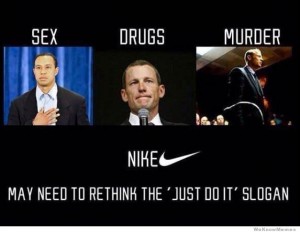#5 – Hockey Canada’s Snazzy New Jerseys Spike Association Controversy
In light to today’s class discussion on Branding, I cam across an interesting article that coincidentally, relates to my previous post about athlete endorsements. Ahead of next month’s Women’s Hockey World Championship in Ottawa, Hockey Canada unveiled new jerseys that feature the yellow and gold colour scheme of cancer charity Livestrong in an effort to raise awareness for cancer research. The jerseys are part of a greater “Fight With Us” campaign run by Livestrong and sponsors Nike and Sport Chek. The only problem? The Livestrong Foundation was started by none other than Lance Armstrong, the disgraced cyclist who admitted to taking performance enhancing drugs throughout his career last January.

While Livestrong undoubtedly remains true to their cause (Armstrong has since stepped down as head of the Foundation), and Hockey Canada’s support of cancer research has to be applauded, the association to Armstrong and what he now symbolizes to North Americans – a cheater and a liar – is impossible to put aside. As Howard Bloom puts it, “Livestrong and Lance Armstrong are married at the hip”.
Is this a mistake? To me, the message that the jersey sends out is a conflicting one. While it supports an incredibly positive cause, that cause has unfortunately been victimized by a man who has lost the respect of a nation and is now dealing with a bevy of lawsuits in light of him being stripped of all his Tour de France titles. Surely, there must have been other cancer charities – The Canadian Breast Cancer Foundation, for instance (teams have worn pink equipment before). Despite this, however, I believe that Hockey Canada’s decision is a sound one. Why? Simply for the fact that the controversy has light up news channels. People are talking about it. Especially for the women’s game, which doesn’t get as much attention as the men’s game, getting a lot of people to be aware of the campaign is better than having a few people support it.

pink skates… a better option?
 Comments(0)
Comments(0)